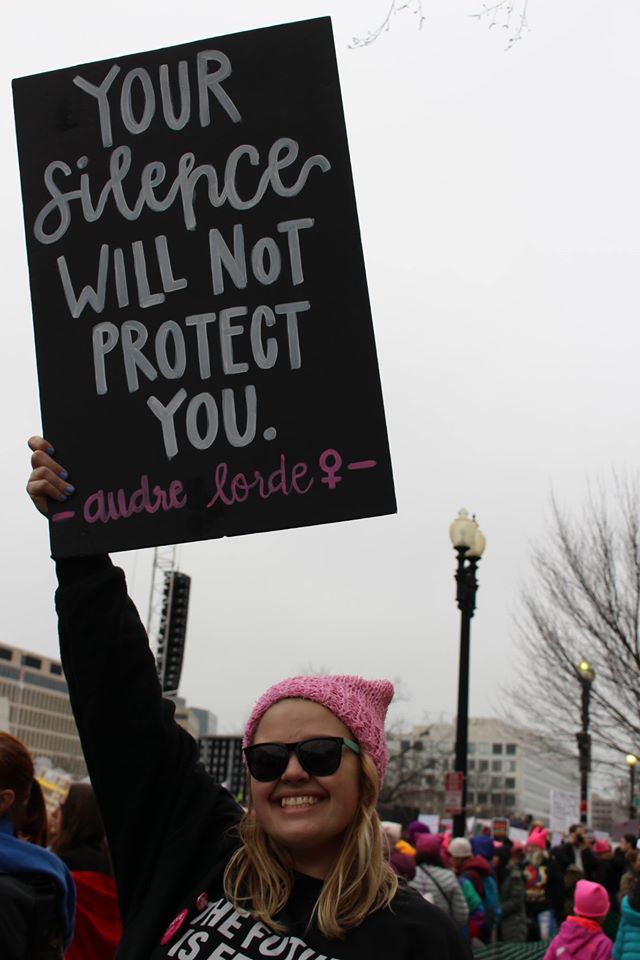
Courtesy of Paige Armstrong via Facebook
By Gabrielle Garay | gargoyle@flagler.edu
Paige Armstrong flips through her phone and scrolls through a seemingly-endless amount of photos.
They show her flanked by other Flagler students proudly holding up signs and marching through the streets of Washington, D.C., joining the thousands of others who traveled to the nation’s capital for the Women’s March.
“I can see us heading for a war on women’s rights, which is pretty unprecedented,” Armstrong said.
As a political activist and Flagler student, Armstrong is outspoken when it comes to her opinion—women’s rights are at stake.
Also outspoken on his views, Donald Trump has made his stance on abortion clear from the beginning—he doesn’t support it. As promised in his campaign, he’s been targeting abortion from early on. It is this unprecedented dismantling that is bringing abortion into the foregrounds of Trump’s administration and is the source of the perceived war on women’s rights.
In his push against abortion in America, Trump started by reinstating the Mexico City policy. The policy, also known as the global gag rule by opposers, blocks U.S. federal funding for non-governmental organizations that provide abortion counseling or referrals. It also prohibits these NGOs from using non-U.S. funds to provide information about abortion as a method of family planning.
Despite criticism, there are supporters of the plan.
“Trump’s main purpose is to look after the American people, putting a stop to any of the money going overseas, sounds mean…but his priority is to first take care of the United States. Once we get our healthcare under control, we can branch out to other countries,” said Jill Martin, a mother of a pro-choice Flagler student.
The Mexico City policy has earned the support of pro-life protestors who are urging the government to continue defunding the government subsidized healthcare provider Planned Parenthood. Both moves have women’s rights activists calling a foul.
“Something like the Mexico City Policy has passed in America, it’s called the Hyde amendment, it’s just a little less known than the gag order that Donald Trump just passed an executive order for,” Armstrong said.
The 1976 amendment has blocked federal Medicaid funding for abortion services, therefore the government isn’t funding abortions, with the exception of three circumstances: when continuing the pregnancy will endanger the woman’s life, or when the pregnancy results from rape or incest.
Planned Parenthood receives funds via reimbursements for the medical services that they provide to patients who either have Medicaid coverage or other publicly funded health care programs. If the funding stopped, it would mean leaving low-income men and women who depend on Medicaid and other public health care programs from accessing care at Planned Parenthood. These people would be blocked from having access to STD testing, cancer screenings, prenatal care, access to low cost contraceptives and more.
As a controversial issue, these actions were taken by the government in an effort to stop what they see as morally corrupt issue, while others see it as an infringement on women’s reproductive health and privacy. Although banning and criminalizing abortion in America stops them from being done legally, that’s all it does. It ends safe, legal abortions. There isn’t a complete and definite end to abortions, but instead, an increase in unsafe at-home abortions. Instead of targeting abortions and criminalizing it, the problem should be solved at the source: conception.
To truly stop abortions in America and abroad, women should be allowed access to the materials to keep them from being pregnant. Defunding Planned Parenthood would block millions from receiving healthcare that they need and can’t afford elsewhere, including access to contraceptives.
Instead, healthcare centers at home and abroad that provide sex education, are involved with family planning, and providing women with the access they need should receive funding. Instead of taking away subsidies, birth control and contraceptives should be subsidized, to ensure every woman has equal access to the medicines that would put her in control of her reproductive health. When the problem is approached strategically and solved at the source, then we can truly end abortion, instead of taking the short cut that harms countless people along the way.
The next step in this battle will be decided in the Senate, as they vote on confirming Neil Gorsuch, the newest supreme court justice. Trump promised to nominate a candidate who would vote to overturn Roe v. Wade and only time will tell if he keeps this promise as he did with the others. As those who Armstrong marched with vow to continue protesting their right to an abortion and reproductive rights, pro-life supporters continue to make their voices heard.




Be the first to comment on "The uncertain future of abortion"